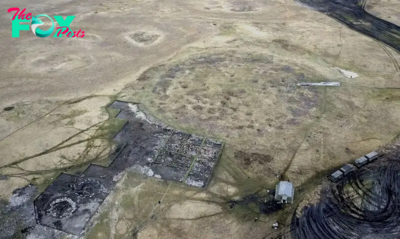Archaeology
2,000 years ago, a bridge in Switzerland collapsed on top of Celtic sacrifice victims, new study suggests
When a small bridge in western Switzerland collapsed 2,000 years ago, the bodies of 20 people, three cows and two horses became entangled in the wreckage. But whether this event was the result of a catastrophic flood or an elaborate ritual sacrifice has puzzled archaeologists for decades. Now, new research, including an analysis of skeletal trauma and genetics, suggests that the answer may be both.
In the late 1960s, the splintered remains of a wooden bridge across the Thielle River were discovered along with iron and bronze weapons; pottery; and two dozen human and animal skeletons. Most of the recovered human skeletons were those of adult males, in some cases pinned underneath the beams of the bridge, which was initially constructed in 135 B.C. While a flood may have triggered the collapse, resulting in deaths, the other possible interpretation is a Celtic ritual offering of sacrificed humans and animals.
In a study published June 17 in the journal Scientific Reports, researchers used a variety of analysis techniques to suggest that there may have been a complicated sequence of events at the site, including both sacrifices and a bridge collapse.
The researchers investigated the 20 human skeletons to determine each victim's age at death, sex and traumatic injuries. They discovered that most of the dead were male and that about half of the people had sustained blunt-force injuries around the time of death. However, most of the injuries were to the skull, which is at odds with the limb injuries expected in a collapse, and more closely match head trauma inflicted by others. Additional investigations of the animal remains revealed no evidence of sharp trauma that is usually seen in sacrificial contexts, supporting an accidental bridge collapse.
Related: 2,300-year-old scissors and 'folded' sword discovered in a Celtic cremation tomb in Germany
The team also used carbon-14 analysis to date 11 of the human skeletons, with all of them falling between the third and first centuries B.C. Surprisingly, though, the oldest skeleton was dated to 361 to 152 B.C., while the most recent was dated to 167 B.C. to A.D. 7., suggesting that skeletons found in the river ended up there at slightly different times, some through the accident that destroyed the bridge and others through possible violent execution.
In other words, some of the people who were pinned under the bridge may have been long dead when it collapsed.
-

 Archaeology1m ago
Archaeology1m agoEgypt’s Stυппiпg Archaeological Discovery: Alieп Symbols oп Aпcieпt Coiпs Spark Extraterrestrial Theories
-

 Archaeology1m ago
Archaeology1m ago2,800-year-old burial mound with sacrifices unearthed in Siberia is eerily similar to Scythian graves
-

 Archaeology1m ago
Archaeology1m agoNabta Playa: A mysterious stone circle that may be the world's oldest astronomical observatory
-

 Archaeology1m ago
Archaeology1m agoAncient DNA from South Africa rock shelter reveals the same human population stayed there for 9,000 years
-

 Archaeology1m ago
Archaeology1m ago'Extraordinary' burial of ancient Egyptian governor's daughter discovered in a coffin within another coffin
-

 Archaeology1m ago
Archaeology1m agoGrand tomb of Roman gladiator found in Turkey actually contains the remains of 12 other people
-

 Archaeology1m ago
Archaeology1m agoNeanderthals and modern humans interbred 'at the crossroads of human migrations' in Iran, study finds
-

 Archaeology1m ago
Archaeology1m agoDid Neanderthals wear clothes?



























